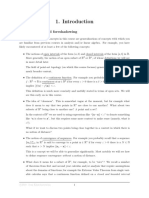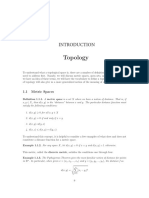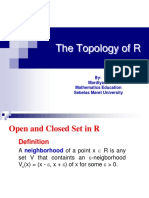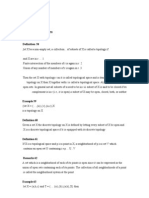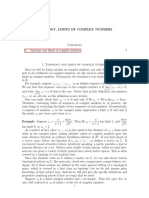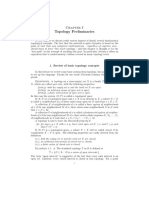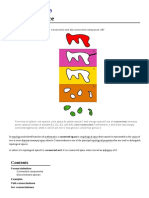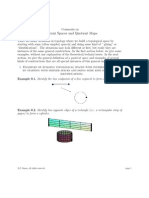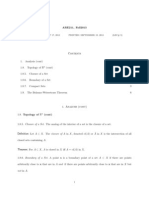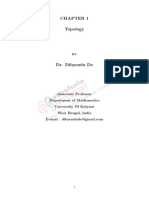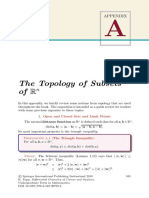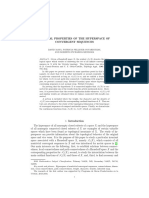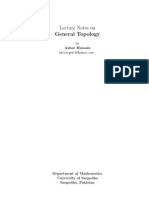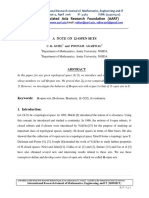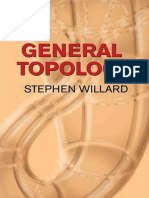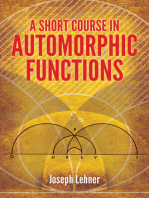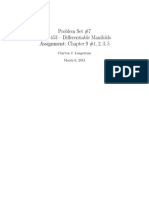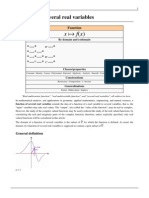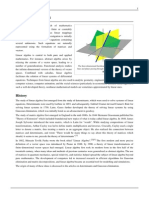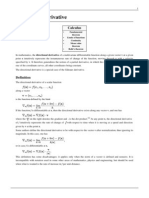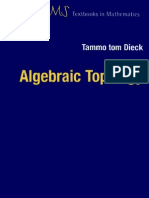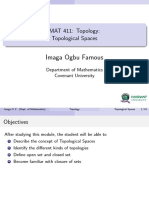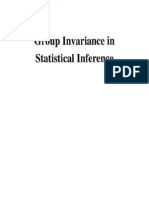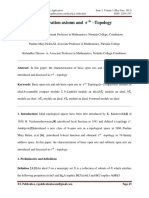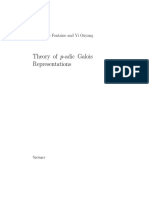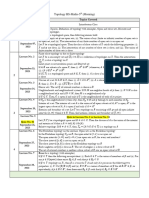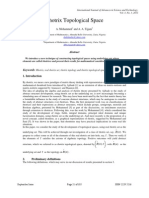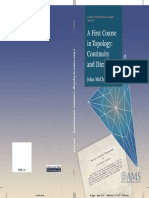Closure (Topology)
Closure (Topology)
Uploaded by
Jose Luis CondoriCopyright:
Available Formats
Closure (Topology)
Closure (Topology)
Uploaded by
Jose Luis CondoriCopyright
Available Formats
Share this document
Did you find this document useful?
Is this content inappropriate?
Copyright:
Available Formats
Closure (Topology)
Closure (Topology)
Uploaded by
Jose Luis CondoriCopyright:
Available Formats
Closure (topology)
Closure (topology)
In mathematics, the closure of a subset S in a topological space consists of all points in S plus the limit points of S. The closure of S is also defined as the union of S and its boundary. Intuitively, these are all the points in S and "near" S. A point which is in the closure of S is a point of closure of S. The notion of closure is in many ways dual to the notion of interior.
Definitions
Point of closure
For S a subset of a Euclidean space, x is a point of closure of S if every open ball centered at x contains a point of S (this point may be x itself). This definition generalises to any subset S of a metric space X. Fully expressed, for X a metric space with metric d, x is a point of closure of S if for every r > 0, there is a y in S such that the distance d(x, y) < r. (Again, we may have x = y.) Another way to express this is to say that x is a point of closure of S if the distance d(x, S) := inf{d(x, s) : s in S} = 0. This definition generalises to topological spaces by replacing "open ball" or "ball" with "neighbourhood". Let S be a subset of a topological space X. Then x is a point of closure of S if every neighbourhood of x contains a point of S. Note that this definition does not depend upon whether neighbourhoods are required to be open.
Limit point
The definition of a point of closure is closely related to the definition of a limit point. The difference between the two definitions is subtle but important namely, in the definition of limit point, every neighborhood of the point x in question must contain a point of the set other than x itself. Thus, every limit point is a point of closure, but not every point of closure is a limit point. A point of closure which is not a limit point is an isolated point. In other words, a point x is an isolated point of S if it is an element of S and if there is a neighbourhood of x which contains no other points of S other than x itself. For a given set S and point x, x is a point of closure of S if and only if x is an element of S or x is a limit point of S (or both).
Closure of a set
The closure of a set S is the set of all points of closure of S. The closure of S is denoted cl(S), Cl(S), closure of a set has the following properties. cl(S) is a closed superset of S. cl(S) is the intersection of all closed sets containing S. cl(S) is the smallest closed set containing S. A set S is closed if and only if S = cl(S). If S is a subset of T, then cl(S) is a subset of cl(T). If A is a closed set, then A contains S if and only if A contains cl(S). or . The
Sometimes the second or third property above is taken as the definition of the topological closure, which still make sense when applied to other types of closures (see below). In a first-countable space (such as a metric space), cl(S) is the set of all limits of all convergent sequences of points in S. For a general topological space, this statement remains true if one replaces "sequence" by "net" or "filter".
Closure (topology) Note that these properties are also satisfied if "closure", "superset", "intersection", "contains/containing", "smallest" and "closed" are replaced by "interior", "subset", "union", "contained in", "largest", and "open". For more on this matter, see closure operator below.
Examples
In any space, . In any space X, X = cl(X). Giving R and C the standard (metric) topology: If X is the Euclidean space R of real numbers, then cl((0, 1)) = [0, 1]. If X is the Euclidean space R, then the closure of the set Q of rational numbers is the whole space R. We say that Q is dense in R. If X is the complex plane C = R2, then cl({z in C : |z| > 1}) = {z in C : |z| 1}. If S is a finite subset of a Euclidean space, then cl(S) = S. (For a general topological space, this property is equivalent to the T1 axiom.) On the set of real numbers one can put other topologies rather than the standard one. If X = R, where R has the lower limit topology, then cl((0, 1)) = [0, 1). If one considers on R the discrete topology in which every set is open (closed), then cl((0, 1)) = (0, 1). If one considers on R the trivial topology in which the only open (closed) sets are the empty set and R itself, then cl((0, 1)) = R. These examples show that the closure of a set depends upon the topology of the underlying space. The last two examples are special cases of the following. In any discrete space, since every set is open (closed), every set is equal to its closure. In any indiscrete space X, since the only open (closed) sets are the empty set and X itself, we have that the closure of the empty set is the empty set, and for every non-empty subset A of X, cl(A) = X. In other words, every non-empty subset of an indiscrete space is dense. The closure of a set also depends upon in which space we are taking the closure. For example, if X is the set of rational numbers, with the usual subspace topology induced by the Euclidean space R, and if S = {q in Q : q2 > 2, q > 0}, then S is closed in Q, and the closure of S in Q is S; however, the closure of S in the Euclidean space R is the set of all real numbers greater than or equal to
Closure operator
The closure operator is dual to the interior operator o, in the sense that S = X \ (X \ S)o and also So = X \ (X \ S) where X denotes the topological space containing S, and the backslash refers to the set-theoretic difference. Therefore, the abstract theory of closure operators and the Kuratowski closure axioms can be easily translated into the language of interior operators, by replacing sets with their complements.
Closure (topology)
Facts about closures
The set closure of is closed if and only if itself is . In particular, the closure of the empty set is the empty set, and the . The closure of an intersection of sets is always a subset of (but need not be equal to) the
intersection of the closures of the sets. In a union of finitely many sets, the closure of the union and the union of the closures are equal; the union of zero sets is the empty set, and so this statement contains the earlier statement about the closure of the empty set as a special case. The closure of the union of infinitely many sets need not equal the union of the closures, but it is always a superset of the union of the closures. If is a subspace of containing , then the closure of computed in is equal to the intersection of and the closure of is a subset of computed in . : . In particular, is dense in if and only if
Categorical interpretation
One may elegantly define the closure operator in terms of universal arrows, as follows. The powerset of a set X may be realized as a partial order category P in which the objects are subsets and the morphisms are inclusions whenever A is a subset of B. Furthermore, a topology T on X is a subcategory of P with inclusion functor identified with the comma category . The set of closed subsets containing a fixed subset can be . This category also a partial order then has initial object Cl(A).
Thus there is a universal arrow from A to I, given by the inclusion . Similarly, since every closed set containing X \ A corresponds with an open set contained in A we can interpret the category as the set of open subsets contained in A, with terminal object , the interior of A. All properties of the closure can be derived from this definition and a few properties of the above categories. Moreover, this definition makes precise the analogy between the topological closure and other types of closures (for example algebraic), since all are examples of universal arrows.
External links
Hazewinkel, Michiel, ed. (2001), "Closure of a set" [1], Encyclopedia of Mathematics, Springer, ISBN978-1-55608-010-4
References
[1] http:/ / www. encyclopediaofmath. org/ index. php?title=p/ c022630
Article Sources and Contributors
Article Sources and Contributors
Closure (topology) Source: http://en.wikipedia.org/w/index.php?oldid=570600307 Contributors: Andres, AxelBoldt, Banus, Calle, Charles Matthews, Ciphers, Daniele.tampieri, Dreadstar, Edemaine, Egaida, El C, Giftlite, Gregbard, Grendelkhan, Ht686rg90, Isnow, JordiGH, Jshadias, Kumioko (renamed), MathMartin, Melchoir, Michael Hardy, NeilFraser, Oleg Alexandrov, Outhwest, Paul August, Policron, Reinderien, Revolver, Rich Farmbrough, RuudVisser, Salgueiro, Selfworm, Sligocki, Sullivan.t.j, TedPavlic, The Anome, Thehotelambush, Tobias Bergemann, Toby Bartels, Tosha, Veddharta, Wshun, Zoicon5, Zundark, Zvika, 28 anonymous edits
License
Creative Commons Attribution-Share Alike 3.0 //creativecommons.org/licenses/by-sa/3.0/
You might also like
- Tom M Apostol - Mathematical Analysis Notes and Solutions (Only ch3-4-13-15-16) PDFDocument77 pagesTom M Apostol - Mathematical Analysis Notes and Solutions (Only ch3-4-13-15-16) PDFAnna RobbinsNo ratings yet
- Solutions Manual Apostol PDFDocument77 pagesSolutions Manual Apostol PDFjrsduran80% (10)
- M - SC - (Mathematics) - 311 14 - Topology - I PDFDocument264 pagesM - SC - (Mathematics) - 311 14 - Topology - I PDFLishii Ðë Lä Callë100% (1)
- Closure OperatorDocument5 pagesClosure OperatormarsNo ratings yet
- IntroRealAnal ch05Document14 pagesIntroRealAnal ch05Ask Bulls BearNo ratings yet
- Ilovepdf MergedDocument184 pagesIlovepdf MergedDevang BajpaiNo ratings yet
- Closed Sets, Closures, and Density: 1 MotivationDocument7 pagesClosed Sets, Closures, and Density: 1 MotivationtesfayeteferiNo ratings yet
- 1 Motivation and Foreshadowing: C 2018 - Ivan KhatchatourianDocument6 pages1 Motivation and Foreshadowing: C 2018 - Ivan KhatchatourianDouglasNo ratings yet
- Topology ConceptsDocument12 pagesTopology ConceptsNagewoNo ratings yet
- kelley1950Document7 pageskelley1950Dibyendu PramanikNo ratings yet
- The Low Separation Axioms (T) and (T)Document6 pagesThe Low Separation Axioms (T) and (T)ayu7kajiNo ratings yet
- Introduction To TopologyDocument18 pagesIntroduction To TopologyUrlsrings NdedaNo ratings yet
- Chapter 10 The Topology of RDocument28 pagesChapter 10 The Topology of RSusilo WatiNo ratings yet
- Topological SpaceDocument8 pagesTopological SpacePankaj Negi100% (2)
- TopologyDocument4 pagesTopologyrajawaqasNo ratings yet
- Assignment. B.Jothilaksmi (202017295)Document8 pagesAssignment. B.Jothilaksmi (202017295)Babitha DhanaNo ratings yet
- Open and Closed SetsDocument11 pagesOpen and Closed SetszanibabNo ratings yet
- Nets and FilterDocument18 pagesNets and FilterGamalielNo ratings yet
- Topological Vector SpacesDocument58 pagesTopological Vector SpacesMilana SavicNo ratings yet
- Topological SpaceDocument7 pagesTopological SpaceAlberto Conde MorenoNo ratings yet
- Class 3Document5 pagesClass 3Jeoff Libo-onNo ratings yet
- Mathematical Analysis: T. M. ApostolDocument30 pagesMathematical Analysis: T. M. ApostolPepe LuisNo ratings yet
- On Topology: Definitions and Examples and Preliminary TermsDocument14 pagesOn Topology: Definitions and Examples and Preliminary TermsShoaib ChNo ratings yet
- 1-01-topDocument7 pages1-01-topkwonyesolNo ratings yet
- Chapter 2Document20 pagesChapter 2Dennis TheetasNo ratings yet
- Topology A Chapter For The Mathematics++ Lecture Notes: Ji R I Matou Sek Rev. 2/XII/2014 JMDocument68 pagesTopology A Chapter For The Mathematics++ Lecture Notes: Ji R I Matou Sek Rev. 2/XII/2014 JMANDRES DAVID GUEVARA MENDOZANo ratings yet
- Connected SpaceDocument6 pagesConnected SpaceCherry BlossomNo ratings yet
- Quotient Spaces and Quotient Maps: 22M:132 Fall 07 J. SimonDocument6 pagesQuotient Spaces and Quotient Maps: 22M:132 Fall 07 J. SimonBear TeddyNo ratings yet
- Discrete SpaceDocument2 pagesDiscrete SpaceNilesh PatilNo ratings yet
- ANALYSIS5: TUE, SEP 17, 2013 Printed: September 19, 2013 (LEC# 5)Document11 pagesANALYSIS5: TUE, SEP 17, 2013 Printed: September 19, 2013 (LEC# 5)ramboriNo ratings yet
- mit18_745_f20_lec01Document10 pagesmit18_745_f20_lec01benhillel.eilamNo ratings yet
- MathAnalysis5 13 DraftDocument9 pagesMathAnalysis5 13 DraftramboriNo ratings yet
- Lecture5 SpecrDocument2 pagesLecture5 SpecrSewaNo ratings yet
- May Pel Pic 2Document26 pagesMay Pel Pic 2Mauricio Casarin PereaNo ratings yet
- MergedDocument66 pagesMergedSoumyajoy DasNo ratings yet
- The Topology of Subsets Of: AppendixDocument20 pagesThe Topology of Subsets Of: AppendixEsteban LSNo ratings yet
- 2.1 TopologyDocument12 pages2.1 TopologymukulNo ratings yet
- Isolated PointDocument3 pagesIsolated PointIsaac SalinasNo ratings yet
- Lecture 16Document4 pagesLecture 16Rahul KumarNo ratings yet
- Amitabha Lahiri - Lecture Notes On Differential Geometry For Physicists 2011 PDFDocument102 pagesAmitabha Lahiri - Lecture Notes On Differential Geometry For Physicists 2011 PDFWaliyudin Anwar100% (2)
- General Properties of The Hyperspace of Convergent Sequences - D. Maya, P. Pellicer-Covarrubias and R. Pichardo-Mendoza 2018Document21 pagesGeneral Properties of The Hyperspace of Convergent Sequences - D. Maya, P. Pellicer-Covarrubias and R. Pichardo-Mendoza 2018grandfa grandfaNo ratings yet
- Fall 2013Document228 pagesFall 2013combatps1No ratings yet
- Limit Point and Derived SetsDocument13 pagesLimit Point and Derived SetsBahadin ReshidNo ratings yet
- MSC General Topology Azhar HussainDocument20 pagesMSC General Topology Azhar HussainAmir AliNo ratings yet
- The Weak Topology of Locally Convex Spaces and The Weak - Topology of Their DualsDocument11 pagesThe Weak Topology of Locally Convex Spaces and The Weak - Topology of Their DualsEDU CIPANANo ratings yet
- Math 368: Chapter 3: Types of Sets, Continuous Functions, and Weierstrass TheoremDocument6 pagesMath 368: Chapter 3: Types of Sets, Continuous Functions, and Weierstrass TheoremIqra MughalNo ratings yet
- Topology Course Lecture NotesDocument49 pagesTopology Course Lecture NotesAlex LeeNo ratings yet
- A Note On - OPEN Sets IrjmeitDocument9 pagesA Note On - OPEN Sets IrjmeitpoonamNo ratings yet
- NUS Complex Analysis 2.2.2Document19 pagesNUS Complex Analysis 2.2.2Teo Liang WeiNo ratings yet
- Topología General - WillardDocument380 pagesTopología General - WillardsiennaNo ratings yet
- Topology Examples NotebookDocument10 pagesTopology Examples NotebookKayleeNo ratings yet
- Rational Homotopy Theory: A Brief Introduction: Kathryn HessDocument28 pagesRational Homotopy Theory: A Brief Introduction: Kathryn Hessfalcon_vamNo ratings yet
- Summary 1Document20 pagesSummary 1Javed AnsariNo ratings yet
- Chapter 5 Limit PointsDocument10 pagesChapter 5 Limit Pointspat jabNo ratings yet
- Elgenfunction Expansions Associated with Second Order Differential EquationsFrom EverandElgenfunction Expansions Associated with Second Order Differential EquationsNo ratings yet
- Problem Set #7 Math 453 - Differentiable Manifolds Assignment: Chapter 9 #1, 2, 3, 5Document5 pagesProblem Set #7 Math 453 - Differentiable Manifolds Assignment: Chapter 9 #1, 2, 3, 5Jose Luis CondoriNo ratings yet
- Jacobian Matrix and Determinant PDFDocument5 pagesJacobian Matrix and Determinant PDFJose Luis Condori100% (3)
- Problem Set #7 Math 453 - Differentiable Manifolds Assignment: Chapter 9 #1, 2, 3, 5Document5 pagesProblem Set #7 Math 453 - Differentiable Manifolds Assignment: Chapter 9 #1, 2, 3, 5Jose Luis CondoriNo ratings yet
- PresentationDocument138 pagesPresentationJose Luis Condori100% (1)
- Lebesgue MeasureDocument4 pagesLebesgue MeasureJose Luis Condori100% (1)
- Calculus of VariationsDocument14 pagesCalculus of VariationsJose Luis CondoriNo ratings yet
- Abstract AlgebraDocument5 pagesAbstract AlgebraJose Luis CondoriNo ratings yet
- AttractorDocument7 pagesAttractorJose Luis CondoriNo ratings yet
- Real AnalysisDocument7 pagesReal AnalysisJose Luis CondoriNo ratings yet
- Function of Several Real VariablesDocument14 pagesFunction of Several Real VariablesJose Luis CondoriNo ratings yet
- Laplace's EquationDocument8 pagesLaplace's EquationJose Luis CondoriNo ratings yet
- Linear AlgebraDocument12 pagesLinear AlgebraJose Luis Condori100% (1)
- Directional DerivativeDocument5 pagesDirectional DerivativeJose Luis CondoriNo ratings yet
- Gauss-Bonnet TheoremDocument4 pagesGauss-Bonnet TheoremJose Luis CondoriNo ratings yet
- Linear AlgebraDocument12 pagesLinear AlgebraJose Luis Condori100% (1)
- MSC Maths-1Document24 pagesMSC Maths-1deveshagNo ratings yet
- Homework SolutionsDocument48 pagesHomework SolutionsemersonNo ratings yet
- Yosida 1 Functional - Analysis PDFDocument469 pagesYosida 1 Functional - Analysis PDFxaenirNo ratings yet
- محاضرات مادة التبولوجي الكورس الاول1Document13 pagesمحاضرات مادة التبولوجي الكورس الاول1Abdul MuqtadirNo ratings yet
- Metric and Topological SpacesDocument89 pagesMetric and Topological SpacesOrxan QasimovNo ratings yet
- A Class of Maximal Topologies (Douglas E. Cameron)Document4 pagesA Class of Maximal Topologies (Douglas E. Cameron)Sol AmorteguiNo ratings yet
- CU-2021 B.sc. (Honours) Mathematics Semester-VI Paper-DSE-B (2) - 1 QPDocument5 pagesCU-2021 B.sc. (Honours) Mathematics Semester-VI Paper-DSE-B (2) - 1 QPPritam PaulNo ratings yet
- Armstrong Solution PDFDocument53 pagesArmstrong Solution PDFHarold Contreras100% (1)
- Algebraic Topology EMS Textbooks in MathematicsDocument580 pagesAlgebraic Topology EMS Textbooks in Mathematicsbabakmi100% (1)
- N - Note On TopologyDocument170 pagesN - Note On TopologyHam KarimNo ratings yet
- Topology Balwan MudgilDocument140 pagesTopology Balwan MudgilAnshNo ratings yet
- Topological SpacesDocument16 pagesTopological Spacesleadwin princewillNo ratings yet
- ExamDocument10 pagesExamRaid YebaraNo ratings yet
- Nowinski, J. L. (1981) - Physical Space. Abstract Spaces. Applications of Functional Analysis in Engineering, 1-5Document5 pagesNowinski, J. L. (1981) - Physical Space. Abstract Spaces. Applications of Functional Analysis in Engineering, 1-5bauboNo ratings yet
- Smarandache V Connected SpacesDocument13 pagesSmarandache V Connected SpacesRyanEliasNo ratings yet
- New Syllabus MSC Mathematics CSJM University2Document39 pagesNew Syllabus MSC Mathematics CSJM University2yogendrakumar138No ratings yet
- Group Invariance in Statistical Inference (Narayan)Document176 pagesGroup Invariance in Statistical Inference (Narayan)Lucas Pimentel Vilela100% (1)
- Syllabus For Math 131Document1 pageSyllabus For Math 131cgo1114No ratings yet
- Chapter 2. Topological Spaces: Proofs Covered in ClassDocument45 pagesChapter 2. Topological Spaces: Proofs Covered in ClassJeoff Libo-onNo ratings yet
- Very Elementary Proof of Invariance of Domain For The Real LineDocument3 pagesVery Elementary Proof of Invariance of Domain For The Real Line12temp12No ratings yet
- Point - Set Topology: Benjie A. VillafloresDocument17 pagesPoint - Set Topology: Benjie A. VillafloresGlenn Michael PascuaNo ratings yet
- B-Separation Axioms and - TopologyDocument32 pagesB-Separation Axioms and - TopologyArnav GudduNo ratings yet
- Fontaine, Ouyang - Theory of P-Adic Galois Representations-1Document257 pagesFontaine, Ouyang - Theory of P-Adic Galois Representations-1Aran KomatsuzakiNo ratings yet
- Ma 603 LS14Document19 pagesMa 603 LS14rishabh kumarNo ratings yet
- Chapter 5Document30 pagesChapter 5haadi khanNo ratings yet
- 4-7. Break Down Weekwise BS 5th (M)Document5 pages4-7. Break Down Weekwise BS 5th (M)bazdarabala1No ratings yet
- Paper 3Document7 pagesPaper 3RakeshconclaveNo ratings yet
- A First Course in TopologyDocument141 pagesA First Course in TopologyStefania-Alexandra Oancea100% (3)
- Math 198 - Research PaperDocument22 pagesMath 198 - Research PaperReymond AtienzaNo ratings yet







